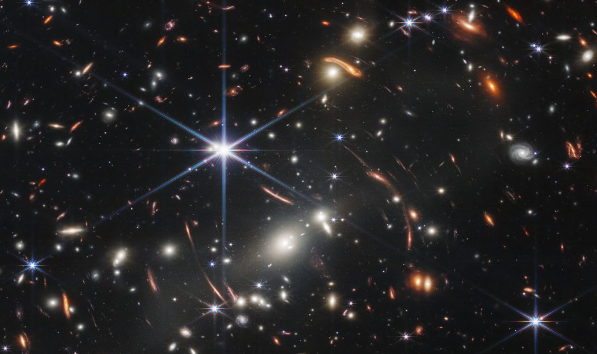James Webb Telescope Discovers Earliest Giant Galaxy
The JADES-GS-z14-0 galaxy, which was seen by NASA’s most advanced space camera to date, was studied in a way that has never been done before by the James Webb Space Camera (JWST). This discovery is very important because it gives us a look into the universe 290 million years after the Big Bang, during a time called the cosmic dawn. Before this, the oldest known galaxy was seen about 320 million years after the Big Bang.
Characteristics of JADES-GS-z14-0
The galaxy that JWST saw is called JADES-GS-z14-0. It is about 1,700 light-years across and has the mass of 500 million sun-sized stars. Amazingly, this galaxy is making 20 new stars every year. This is a very high rate for how young the universe is being formed. The JWST Advanced Deep Extragalactic Survey (JADES) helped make the finding, which shows not only how big the galaxy is but also how bright it is.
Implications of the Discovery
The fact that there is such a big and bright galaxy in this early stage of the universe makes us think about how galaxies form and change over time. The smaller JADES-GS-z14-1 galaxy, which was found along with the second-oldest known galaxy, continues to add to the complexity of what happened in the early universe.
Theories Behind the Early Galaxy Brightness
Scientists are interested in JADES-GS-z14-0’s brightness, which has led to a number of theories. In the past, this level of brightness could have been caused by supermassive black holes. However, this has been ruled out as unlikely in this case because the light is spread out more than would be predicted from a black hole. Other ideas being thought about are that these early galaxies might have more stars than expected, or that these stars are naturally brighter than later generations.
Facts about the James Webb Space Telescope (JWST)
Launch and Location:
- The James Webb Space Telescope (JWST) was launched on December 25, 2021.
- JWST operates 1.5 million kilometers from Earth, significantly further than the Hubble Space Telescope.
Design and Capabilities:
- Features a 6.5-meter diameter primary mirror with a segmented design for high-resolution infrared observation.
- Specialized for observing infrared light, crucial for viewing distant galaxies and exoplanets.
- Keeps the temperature at -233 degrees Celsius to make it more sensitive to infrared light.
- Equipped with a sun-shield the size of a tennis court to protect instruments from solar heat and light.
Mission Objectives and Lifespan:
- Includes studying galaxy formation, the evolution of the universe, and the atmospheres of exoplanets.
- Planned mission duration of over 10 years, with potential for extension based on performance and resources.
Month: Current Affairs - June, 2024
Category: Science & Technology Current Affairs







